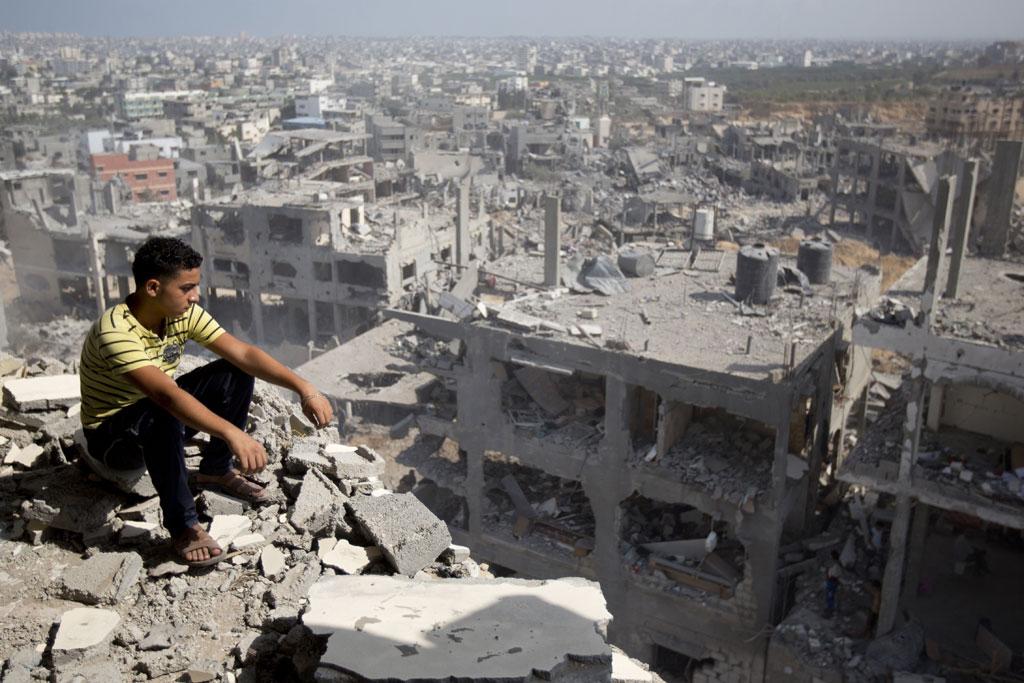Hamas says it has deported foreign journalists for reporting on missile launches
A Palestinian man looks out over destruction in part of Gaza City’s al-Tufah neighborhood on Aug. 6, 2014.
JERUSALEM — Did Hamas, the Islamist group that rules Gaza, intimidate, harass or even deport journalists trying their damnedest to cover a dangerous war with Israel?
If you take Hamas' word for it, the answer appears to be yes.
In an interview with the Lebanese-based Al Mayadeen TV, Hamas spokeswoman Isra Almodallal said that foreign journalists have been deported from Gaza for filming Hamas rocket launches.
Why? According to Almodallal, they "were fixated on the notion of peace and on the Israeli narrative. So when they were conducting interviews or when they went on location to report they would focus on filming the places from where the missiles were launched. Thus, they were collaborating with the occupation."
Hamas is not an organization that takes perceived support for the occupation lightly. Last month, 30 Gazans accused of collaboration with Israel were executed without trial.
Up until now, many have considered claims by Israel and the nonprofit Foreign News Association that Hamas was harassing journalists to be exaggerated.But the question has been hotly contested in conversations among journalists here since the start of the conflict on July 8.
Almodallal may have been referring specifically to the audacious Shreenivasan Jain, correspondent for India's NDTV, who with his crew broadcast an exclusive view of Hamas building and launching rockets "right next to our hotel" earlier this month.
"These journalists were deported from the Gaza Strip. The security agencies would go and have a chat with these people. They would give them some time to change their message, one way or the other," said Almodallal, who is identified as a spokesperson for the Palestinian Information Ministry.
Almodallal was a spokeswoman for the Hamas government until the establishment of the unity government in June. At that point, appointees of Fatah, the majority party of the Palestinian government in Ramallah, took over all official positions. Almodallal now identifies herself on Twitter as an "independent journalist and a Palestinian activist."
"Some of the journalists who entered the Gaza Strip were under security surveillance," she explained in a video uploaded to YouTube. "Even under these difficult circumstances we managed to reach them and tell them that what they were doing was anything but professional journalism and was immoral."
On Tuesday, the Foreign News Association, an independent body that represents all of the almost 800 foreign journalists based in Israel and Palestine, issued a rare and scathing statement protesting "in the strongest terms the blatant, incessant, forceful and unorthodox methods employed by the Hamas authorities and their representatives against visiting international journalists in Gaza over the past month."
A public brouhaha ensued, displaying journalistic antagonism and ideological discord usually kept under the wrap of polite conversation.
New York Times chief correspondent Jodi Rudoren, tweeting from Gaza but basing her information on reports from others who had been there during the heavy weeks of fighting, declared the FPA statement "nonsense."
Similarly, Lisa Goldman, the New York-based director of the Israel-Palestine Initiative at the New America Foundation, said that there were "no reports" of journalists impeded in reporting the Gaza story.
In her interview, Almodallal was almost certainly not referring to The New York Times' Pulitzer Prize-winning photographer Tyler Hicks, who was questioned about the lack of images of Hamas militants or weaponry in his coverage of the war. In a response, he wrote, "This is a war fought largely behind the scenes. Hamas fighters are not able to expose themselves. If they were even to step a foot on the street they would be spotted by an Israeli drone and immediately blown up. We don't see those fighters."
Then, seemingly confirming the Israeli contention that Hamas uses residential areas to shield themselves from Israeli retaliation, he added, "They are operating out of buildings and homes and at night. They are moving around very carefully. You don't see any signs of authority on the streets."
The few members of the foreign media willing to speak openly on the matter are divided.
But in a tweet subsequently deleted, Wall Street Journal correspondent Nick Casey posted the image of a Hamas spokesman setting up for an interview and commented, "You have to wonder w the shelling how patients at Shifa hospital feel as Hamas uses it as a safe place to see media.”
FPA chairman Samer Shalabi, who is a longtime producer and cameraman for the Canadian Broadcasting Corporation, was nonplussed by the Almodallal assertions. Saying he had no real comment on the matter, he concluded "she's exactly proven everything we are saying."
